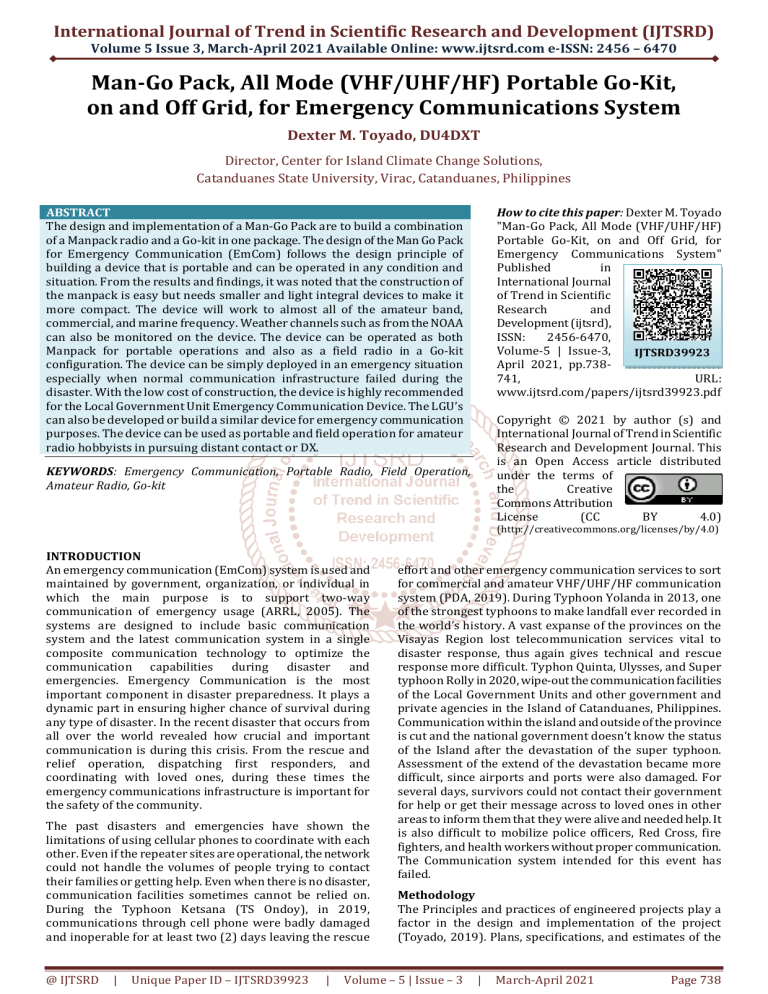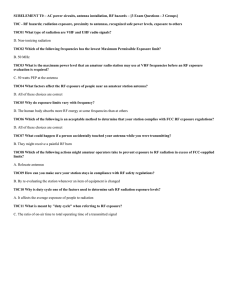
International Journal of Trend in Scientific Research and Development (IJTSRD)
Volume 5 Issue 3, March-April 2021 Available Online: www.ijtsrd.com e-ISSN: 2456 – 6470
Man-Go Pack, All Mode (VHF/UHF/HF) Portable Go-Kit,
on and Off Grid, for Emergency Communications System
Dexter M. Toyado, DU4DXT
Director, Center for Island Climate Change Solutions,
Catanduanes State University, Virac, Catanduanes, Philippines
ABSTRACT
The design and implementation of a Man-Go Pack are to build a combination
of a Manpack radio and a Go-kit in one package. The design of the Man Go Pack
for Emergency Communication (EmCom) follows the design principle of
building a device that is portable and can be operated in any condition and
situation. From the results and findings, it was noted that the construction of
the manpack is easy but needs smaller and light integral devices to make it
more compact. The device will work to almost all of the amateur band,
commercial, and marine frequency. Weather channels such as from the NOAA
can also be monitored on the device. The device can be operated as both
Manpack for portable operations and also as a field radio in a Go-kit
configuration. The device can be simply deployed in an emergency situation
especially when normal communication infrastructure failed during the
disaster. With the low cost of construction, the device is highly recommended
for the Local Government Unit Emergency Communication Device. The LGU’s
can also be developed or build a similar device for emergency communication
purposes. The device can be used as portable and field operation for amateur
radio hobbyists in pursuing distant contact or DX.
How to cite this paper: Dexter M. Toyado
"Man-Go Pack, All Mode (VHF/UHF/HF)
Portable Go-Kit, on and Off Grid, for
Emergency Communications System"
Published
in
International Journal
of Trend in Scientific
Research
and
Development (ijtsrd),
ISSN:
2456-6470,
Volume-5 | Issue-3,
IJTSRD39923
April 2021, pp.738741,
URL:
www.ijtsrd.com/papers/ijtsrd39923.pdf
Copyright © 2021 by author (s) and
International Journal of Trend in Scientific
Research and Development Journal. This
is an Open Access article distributed
under the terms of
the
Creative
Commons Attribution
License
(CC
BY
4.0)
KEYWORDS: Emergency Communication, Portable Radio, Field Operation,
Amateur Radio, Go-kit
(http://creativecommons.org/licenses/by/4.0)
INTRODUCTION
An emergency communication (EmCom) system is used and
maintained by government, organization, or individual in
which the main purpose is to support two-way
communication of emergency usage (ARRL, 2005). The
systems are designed to include basic communication
system and the latest communication system in a single
composite communication technology to optimize the
communication capabilities during disaster and
emergencies. Emergency Communication is the most
important component in disaster preparedness. It plays a
dynamic part in ensuring higher chance of survival during
any type of disaster. In the recent disaster that occurs from
all over the world revealed how crucial and important
communication is during this crisis. From the rescue and
relief operation, dispatching first responders, and
coordinating with loved ones, during these times the
emergency communications infrastructure is important for
the safety of the community.
The past disasters and emergencies have shown the
limitations of using cellular phones to coordinate with each
other. Even if the repeater sites are operational, the network
could not handle the volumes of people trying to contact
their families or getting help. Even when there is no disaster,
communication facilities sometimes cannot be relied on.
During the Typhoon Ketsana (TS Ondoy), in 2019,
communications through cell phone were badly damaged
and inoperable for at least two (2) days leaving the rescue
@ IJTSRD
|
Unique Paper ID – IJTSRD39923
|
effort and other emergency communication services to sort
for commercial and amateur VHF/UHF/HF communication
system (PDA, 2019). During Typhoon Yolanda in 2013, one
of the strongest typhoons to make landfall ever recorded in
the world’s history. A vast expanse of the provinces on the
Visayas Region lost telecommunication services vital to
disaster response, thus again gives technical and rescue
response more difficult. Typhon Quinta, Ulysses, and Super
typhoon Rolly in 2020, wipe-out the communication facilities
of the Local Government Units and other government and
private agencies in the Island of Catanduanes, Philippines.
Communication within the island and outside of the province
is cut and the national government doesn’t know the status
of the Island after the devastation of the super typhoon.
Assessment of the extend of the devastation became more
difficult, since airports and ports were also damaged. For
several days, survivors could not contact their government
for help or get their message across to loved ones in other
areas to inform them that they were alive and needed help. It
is also difficult to mobilize police officers, Red Cross, fire
fighters, and health workers without proper communication.
The Communication system intended for this event has
failed.
Methodology
The Principles and practices of engineered projects play a
factor in the design and implementation of the project
(Toyado, 2019). Plans, specifications, and estimates of the
Volume – 5 | Issue – 3
|
March-April 2021
Page 738
International Journal of Trend in Scientific Research and Development (IJTSRD) @ www.ijtsrd.com eISSN: 2456-6470
structures are derived from good engineering practices that
device by independent users as well as performing tests
will result in a good and reliable device. Devices and
using electronic measuring instrumentations. The design is
instruments, such as radio, tuners, battery, the solar panel
focused on the lowest weight to needs criteria. The
are selected based on their usability and applicability for the
construction will also use value engineering to obtain the
project. The criteria of selection for this are; low cost, low
lowest cost versus performance. Computer Software will
weight and small form factor, reliability, and able to operate
help analyze the performance of the device. Testing done by
with low power and QRP mode. The device will be designed
a human operator will also be evaluated by the performance
to perform the desired performance. Testing is done for the
and operability as intended of the device.
Design of the Device
The design of the man pack/Go kit for Emergency Communication follows the design principle of building a device that is
portable and can be operated in any condition and situation. This design and construction will be based on all available lowcost materials and radios for the project. The element and parts diagram of the device is shown in Fig 1.
Figure 1 – The device diagram
Components
The components are sourced out from local and international supplier to acquire the best fit part for the device.
Table 1- Components of the device
Component
Description
Solar Panel
10 watts with 12V Cell Solar Panel Module
Rugged, innovative, multiband, multimode portable transceiver for the amateur radio
MF/HF/VHF/UHF bands. Providing coverage of the 160-10 meter bands plus the 6 m, 2 m,
Radio
and 70 cm bands, includes operation on the SSB, CW, AM, FM, and Digital modes, and it's
capable of 20-Watt portable operation using internal batteries, or up to 100 Watts when
using an external 13.8-volt DC power source.
valve-regulated lead-acid battery (VRLA), maintenance free motorcycle battery, designed
Power supply 1 (Battery)
for motorcycle for maximum performance and excellent reliability
Switching power supply to supply the radio for a 100w output capability on HF and 50
Power Supply 2
watts on VHF and 25 watts on UHF. It is lightweight and efficient. 30 amps rated current
(Switching Power Supply)
with 12V output voltage
Solar controller unit, 12/24V auto, 10 amps rated current, with +5V/1.2A USB terminal
Solar Controller Unit
output which can charge mobile phone, fans and other electronic device
Mobile monoband antenna for portable operation. Small, lightweight, efficient, and easy-toAntenna 1
use. Dual center and distributed loading that radiates efficiently
VHF/UHF rubber ducky antenna. Electrically short monopole antenna that functions
Antenna 2
somewhat like a base-loaded whip antenna. Maximum gain is 2.15dBi (430MHz )
Antenna 3 (optional for
Dipole antenna that consists of a conductive wire or rod that is half the length of the
Field – Go-Kit Operation)
maximum wavelength the antenna is designed to operate at end to end.
Aluminum for lightweight and rigid construction. 1” Angular aluminum and 1” Flat bar
Chassis of the device
aluminum are used for main frame structure. Rivets are used to connect the chassis.
Painted with Automotive paint for durability and aesthetic appearance
Wires, switches,
Automotive wire for operation in a DC mode. Commercial grade double throw switch.RG58
and connectors
coaxial wire for radio transmitter and antenna. PL259 and eye terminal for connectors
@ IJTSRD
|
Unique Paper ID – IJTSRD39923
|
Volume – 5 | Issue – 3
|
March-April 2021
Page 739
International Journal of Trend in Scientific Research and Development (IJTSRD) @ www.ijtsrd.com eISSN: 2456-6470
Assembly of the Device
The subsequent steps are followed to build the device
1. Preparation of all materials, equipment, and tools.
2. Assembly of chassis that includes cutting of aluminum Angle bar 2 pcs 22mm, 4pcs - 37mm 2 pcs 17mm, Aluminum Flat
bars 2 pcs - 22 mm , 2 pcs - 17mm, and 50mm angle bars and bent for antenna mounting. of the antenna. To hold battery
and switches, additional 4 pcs 10mm angle. Rivets is used to form the chassis. Sprayed with automotive paint for
durability.
3. Assembly of the Power Source. Cut automotive wires exactly to the length of the connections between power sources and
connect the witches. Trim the power voltage of the Power Switching Supply to 13.9 volts
4. Assembly of the controllers. Connect the power sources to the controllers, and test the connections.
5. Attached the power source and switches to the chassis
6. Attached radio and tuners
7. Attached controllers
8. Attached antenna system
Figure 2 Completed devices in Go-kit and Manpack configurations
Results
The design of the Man-Go Pack for EmCom follows the
design principle of building a device that is portable and can
be operated in any condition and situation. The construction
is made up of aluminum material for lightweight and
portability. The actual size of the device is 22cm width, 37
cm depth, and 17 cm height without the external power
switching supply. The width increases to 26cm if the PS is
connected to the chassis. The chassis can be encased into a
piece of luggage and or a backpack making it more versatile
and easier to transport in the field. Pedestrian operation is
convenient since it can be operated in front of the user at the
back while in transit or in motion. The antenna can be a
sweep, for field operation and on pedestrian mode. The
device, therefore, is compact and in one package.
The device utilizes HF, VHF, and UHF radio band to enable
the operator of the device to contact h other stations,
government agencies, rescue, and other radio services. For
amateur Frequency, almost all of the amateur band can be
operated by the device. On amateur Radio Service in the
Philippines, The Philippine Amateur Radio Association or
DX1PAR uses 7.095 as standby frequency for the National
Traffic System in the Philippines. The device is set to this
frequency as it is the primary frequency for Ham Emergency
Radio Operation (HERO) in the Philippines.
On 2-meter band, all frequencies from 144.00 MHz to 146.00
MHz can be covered by the device including 145.00 MHz
which is the emergency calling frequency of the Philippines.
From the Memorandum Order No. 01006-2012 of the
National Telecommunication Commission (NTC), frequencies
are allocated for the exclusive use and operations of the
@ IJTSRD
|
Unique Paper ID – IJTSRD39923
|
radio communication system of any agencies, organization,
responding to disaster and emergencies under the close
supervision of the National Disaster Risk Reduction and
Management Council (NDRRMC); as follows TX/RX:
440.225/445.225 MHz, and TX/RX: 430.375/445.375 Mhz.
The device is equipped with the UHF band can be used in
these frequencies thus the device is useable in Emergency
Communications. The device can even to the commercial
frequency in order to make a two-way communication from
the National Government Agency, Non-government
Organization, and other Radio Volunteers Network.
The device can transmit and listen to the marine frequency
as designated. It is capable of monitoring distress call in
marine frequency used by marine transportation and also a
commercial fishing vessel within the Pacific and the West
Philippine seas. Most of commercial fishing vessels in the
Philippines, fishing the area such as Bajo de Masinloc and
Panatag Shoal can be monitored and make two-way
communication using the device. Their fisherman are using
the frequency 7.400 MHz, on USB (Upper Side Band) to
communicate with other fishermen’s on the seas and on the
land. The device can also listen to the weather channel on
VHF for the latest weather update and conditions.
The device can also be used as a portable charger for
electronic devices such as cell phone, laptop, and iPad. The
controller is equipped with a 5 volts output USB-type
connector to charge mobile devices. The 12 volts output of
the battery can be also used to power light bulbs of 12 volts
rating. Since the controller can be switch to 24volts mode, a
laptop charger can be connected using an alligator connector
for charging. With the on-board Power switching devices, the
Volume – 5 | Issue – 3
|
March-April 2021
Page 740
International Journal of Trend in Scientific Research and Development (IJTSRD) @ www.ijtsrd.com eISSN: 2456-6470
device can also power other radios, gadgets, lighting systems
that are using a 12-volt DC or direct current.
LGU’s can also be developed or build a similar device for
emergency communication purposes.
The device is designed to be an off-grid on-grid EmCom
Radios. The device can run on a 220V Alternating Current
from the grid line. With this mode, the radio can produce a
maximum output of 100watts on HF, 50 watts on VHF, and
20watts on UHF. Can also use big antennas for longer
contact. The off-grid mode is a feature of the device for Man
pack Operation. The unit is being powered by a 12volts, 5AH
battery. The battery can power the unit with 5 watts of
power in HF, UHF, and VHF mode. The battery can be used
for 24hours in standby or monitoring mode and 6hours in
transmitting mode on normal QSO.
References
[1] ARRL, 2005, The ARRL Amateur Radio Emergency
Communications Course Level I, Copyright 2004-2005
ISBN: 0-87259-846-2
The rigid construction and design of the device, and its
lightweight, give the operator in a Man pack mode to
communicate in two way in bot HF, UHF, and VHF mode with
5 watts or QRP mode. The device can be operated in a
Pedestrian mode. It can also be a good choice for hams
operation in SOTA or Summit on the Air Operation. It can be
easily packed inside a 40 liters backpack.
The device can also be used as a tactical, go kit mode for
command center used in field communication, emergency
communication, and contest communication. The device can
be easily deploying in a table and operates with the onboard
antenna system for QRP mode. For more power, if the device
is connected to a grid system, the device can operate in
100watts of power in HF, 50 watts on VHF, and 20watts on
UHF.
Conclusion and Recommendation
The construction of the man pack is easy but needs smaller
and light integral devices to make it more compact. The
device will work to almost all of the amateur band,
commercial, and marine frequency. Weather channels such
as from the NOAA can also be monitored on the device. The
device can be operated as both Man pack for portable
operations and also as a field radio in a Go-kit configuration.
The device can be simply deployed in an emergency
situation especially when normal communication
infrastructure failed during the disaster. With the low cost of
construction, the device is highly recommended for the Local
Government Unit Emergency Communication Device. The
@ IJTSRD
|
Unique Paper ID – IJTSRD39923
|
[2]
Dan O’Connor, , KE7HLR, 2008, Personal Go-Kit For
Emergency Communications Emcommwest 2008
Reno, Nevada May 2–4, 2008
[3]
Dexter M. Toyado, 2019, Design and Implementation
of A VHF Tri-Loop Antenna for 2-Meter Amateur
Band, Published in International Journal of Trend in
Scientific Research and Development (ijtsrd), ISSN:
2456- 6470, Volume-3 | Issue-6, October 2019, pp.
481-485,
URL:
https://www.ijtsrd.com/papers/ijtsrd28120.pdf
[4]
Dexter M. Toyado, 2020, Disaster Preparedness of
Local Government Units Communication Systems in
Catanduanes, Philippines, Journal of Communication
Engineering and Its Innovations Volume-6, Issue-2
(May-August, 2020), www.matjournals.com
[5]
Harris Corporation, 2000, Radio Communications
inthe Digital Age Volume Two: VHF/UHF Technology,
Library of Congress Catalog Card Number: 00 132465
Harris Corporation, RF Communications Division
[6]
JimKennedy, 2006, Alternate Communications during
Times of Disaster, Telecoms continuity. Continuity
Central: the international business continuity
management portal, www.continuitycentral.com
[7]
NTC, Memorandum Order 01-06-2012- Allocation of
Common Frequency during Disaster and Calamities,
National Telecommunication Commission.
[8]
PDA, 2009, Situation Report Philippines - Typhoon
Ondoy,https://reliefweb.int/report/philippines/situa
tion-report-philippines-typhoon-ondoy
[9]
Robert Richardson, 2011, Emergency Communication,
Ham Radio - Emergency Communications
(offgridsurvival.com)
Volume – 5 | Issue – 3
|
March-April 2021
Page 741


